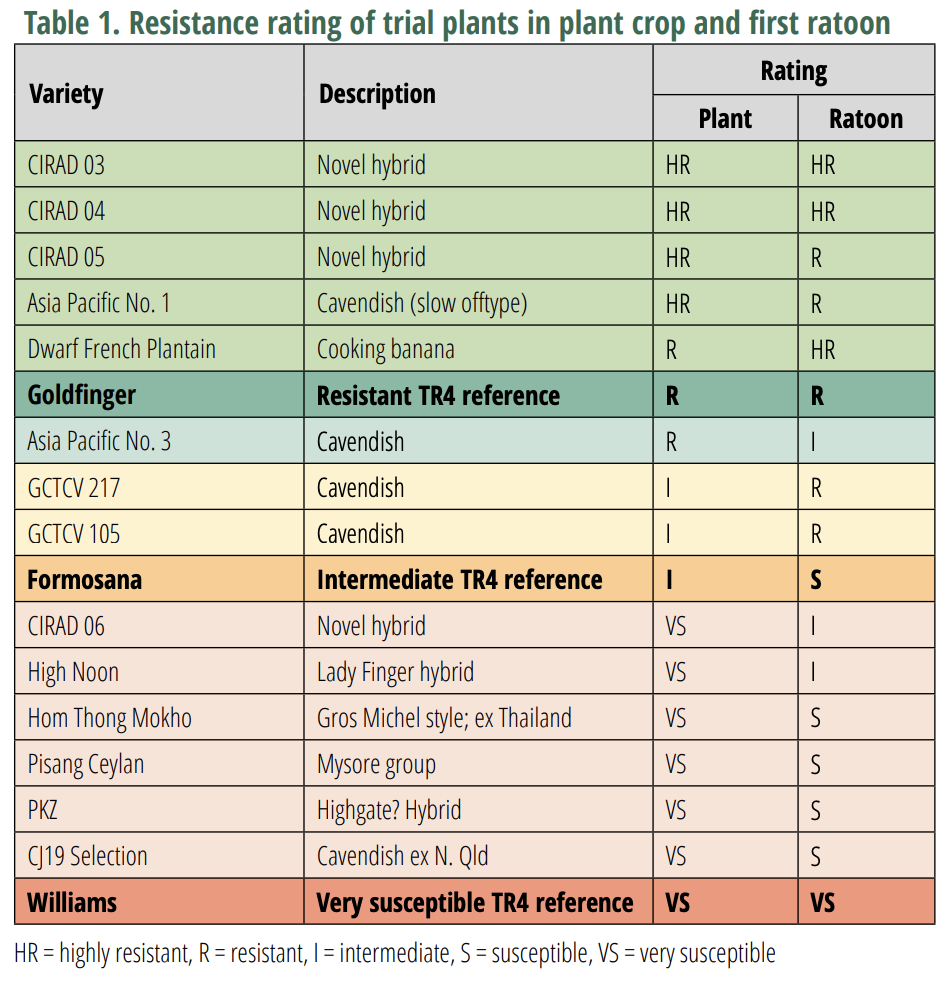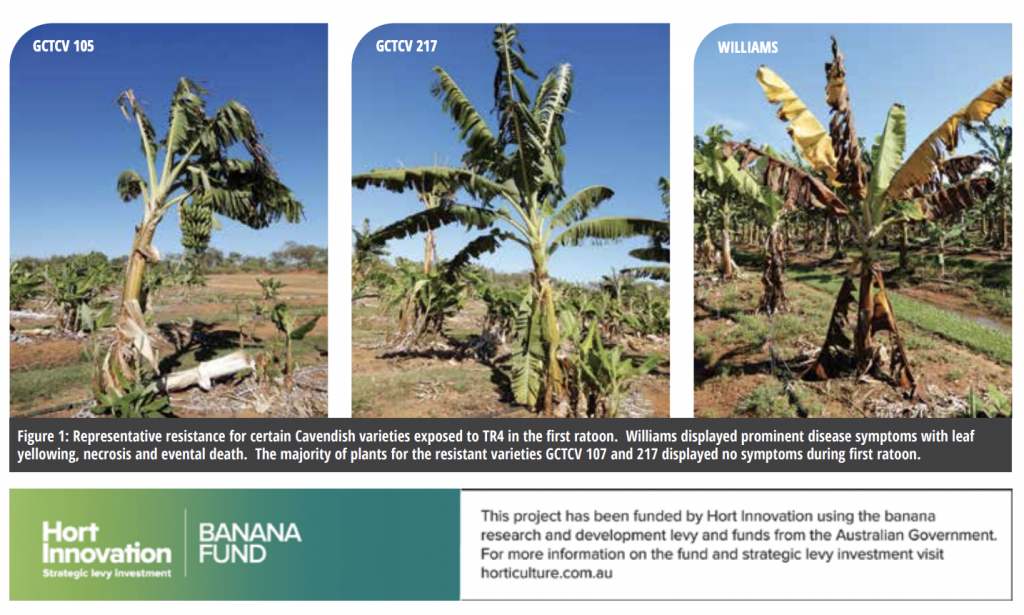By Sharl Mintoff1 , Samantha Cullen1 , Chris Kelly1 , Maxine Piggott1 and Jeff Daniells2
1 Northern Territory Department of Industry, Tourism and Trade, Darwin, NT
2 Queensland Department of Agriculture and Fisheries, South Johnstone, QLD
Eight varieties in a banana variety trial in the Northern Territory have demonstrated better resistance to TR4 than Formosana which include two Cavendish selections being considered for the next phase of pre-commercialisation trials.
Three of the hybrids from the CIRAD breeding program in the French West Indies displayed better resistance than Goldfinger. The final disease assessments for the banana variety trial in the Northern Territory (NT) were completed in August 2020. This trial is part of the ‘Improved plant protection for the banana industry’ project (BA16001). The overall trial screened 32 varieties (including three reference varieties) and assessed their resistance to Panama disease Tropical race 4 (TR4).
The trial ran for 20 months with most of the surviving varieties completing their first ratoon crop cycle. As a reminder, this trial was split into two parts, previously referred to as “Main trial” and “Sub-trial” owing to a shortage of plants of the CIRAD breeding program parental lines that were included. For the sake of clarity we have chosen to report the results as two separate articles – one in this magazine and one in the next edition.
Here in Part 1 (Main trial) we focus on the results of the Cavendish lines, CIRAD hybrids and some miscellaneous selections, categorising their performance based on resistance or susceptibility to TR4.
Part 2 (Sub-trial), in the next edition, will focus on the CIRAD parental lines. The plant crop results for this trial were reported in the August 2020 edition of Australian Bananas (pp 20-21).
METHODS
All plants in this trial were artificially inoculated at planting with TR4 colonised millet. Three reference varieties acted as control treatments for comparison, Williams – Very Susceptible; Formosana (GCTCV 218) – Intermediate; and Goldfinger (FHIA-01) – Resistant, as their reactions are well known and act as a reference point for the other test varieties.
Disease assessments were carried out fortnightly once external symptoms became apparent in a susceptible variety. Assessments included noting the appearance of external disease symptoms and internal symptoms at plant death or harvest. Disease performances of a particular variety were given a score and grouped into one of the following categories:
Highly Resistant (HR) – No disease symptoms were observed within the crop cycle and may not show symptoms under high inoculum pressures.
Resistant (R) – Plants normally show no signs of infection in the presence of the pathogen. However, under high inoculum pressures low amounts of symptoms or losses may occur.
Intermediate (I) – Plants which can withstand some infection and suffer low losses under natural infestation conditions, with most completing their crop cycle. However, its susceptibility or resistance can be highly dependent on the inoculum pressure already present. With the appropriate crop management or environment to lower the inoculum levels, these should be commercially viable.
Susceptible (S) – More than 50% of plants show symptoms and/or killed due to pathogen infection.
Very susceptible (VS) – Majority of plants (more than 70%) showed severe symptoms, most of which died due to TR4.
RESULTS
Interestingly there appeared to be a reduction in disease severity observed across the first ratoon crop compared to the plant crop, with dramatic shifts occurring for a couple of varieties (Table 1).
Highly Resistant
CIRAD 03 and CIRAD 04 retained their resistance seen in the previous crop cycle continuing to be classified as highly resistant into the first ratoon. Dwarf French Plantain moved up into this category with no disease symptoms noted in the ratoon crop.
Resistant
Varieties Asia Pacific No.1 and CIRAD 05 both displayed low incidences of TR4 infection in the first ratoon moving them down into the resistant category. GCTCV 105 and GCTCV 217 (Figure 1) both moved up into the resistant category after displaying a slight reduction in disease development in the ratoon crop. The resistant reference Goldfinger remained in this category.
Intermediate
Asia Pacific No.3 moved down into this category due to an increase in plants infected with TR4 in the ratoon crop cycle. CIRAD 06 and High Noon, showed a dramatic reduction in the number of affected plants in the ratoon crop moving them up from very susceptible (in the plant crop) into the intermediate category.
Susceptible and Very Susceptible
Varieties that were deemed susceptible within the first ratoon crop cycle included Hom Thong Mokho, Pisang Ceylan, PKZ and the CJ19 Selection. The intermediate reference variety Formosana displayed an increase in disease severity in the first ratoon crop and as a result was moved down into the susceptible category. The susceptibility of the very susceptible reference variety Williams did not change.
CONCLUSION
Generally, the focus of the NT screening trials is to identify resistant varieties, especially those that display similar or better resistance than Formosana, as it is used as the benchmark for the lowest acceptable level of resistance. In this trial eight varieties demonstrated better resistance than Formosana, which include Cavendish and CIRAD lines.
The Cavendish selections Asia Pacific No.3 and GCTCV 217 both performed better than Formosana against TR4 and have also performed fairly well agronomically in north Queensland, so they are being considered for on-farm pre-commercialisation trials in 2022. There were 2 other Cavendish with intermediate or resistant reactions: the Asia Pacific No.1 plants were all tissue culture offtypes (very slow and low yielding), whilst the fruit of GCTCV 105 was too short in South Johnstone trials, with significantly less fruit in the currently required size range for market.
The continued good performance of Dwarf French Plantain against TR4 is encouraging for the few commercial producers of this type of niche variety. The CIRAD lines 03, 04 and 05 all had outstanding resistance against TR4 across the 2 crops which is very encouraging for the French breeding program. However, growers must understand that these are not Cavendish and so the fruit they produce does not slot readily into the current market requirements. The plants are taller making them more difficult to manage and subject to greater wind damage.
Although apparent “recovery” occurred in some varieties within the first ratoon crop, a degree of caution is required when interpreting these results, particularly in the case of CIRAD 06 and High Noon. Although the results of those two varieties are very interesting, this would need to be investigated further to determine how repeatable such a recovery is, and whether indeed, it would continue into later ratoon crops.


